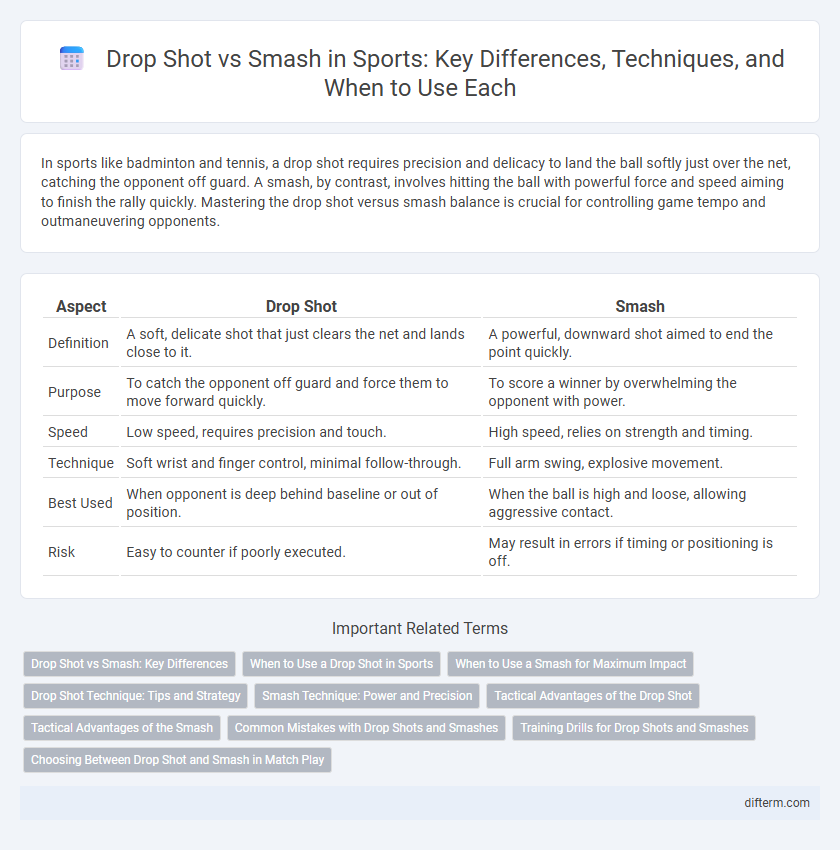In sports like badminton and tennis, a drop shot requires precision and delicacy to land the ball softly just over the net, catching the opponent off guard. A smash, by contrast, involves hitting the ball with powerful force and speed aiming to finish the rally quickly. Mastering the drop shot versus smash balance is crucial for controlling game tempo and outmaneuvering opponents.
Table of Comparison
| Aspect | Drop Shot | Smash |
|---|---|---|
| Definition | A soft, delicate shot that just clears the net and lands close to it. | A powerful, downward shot aimed to end the point quickly. |
| Purpose | To catch the opponent off guard and force them to move forward quickly. | To score a winner by overwhelming the opponent with power. |
| Speed | Low speed, requires precision and touch. | High speed, relies on strength and timing. |
| Technique | Soft wrist and finger control, minimal follow-through. | Full arm swing, explosive movement. |
| Best Used | When opponent is deep behind baseline or out of position. | When the ball is high and loose, allowing aggressive contact. |
| Risk | Easy to counter if poorly executed. | May result in errors if timing or positioning is off. |
Drop Shot vs Smash: Key Differences
Drop shots use finesse and touch to send the ball just over the net, forcing opponents to move forward quickly, while smashes involve powerful, aggressive overhead strikes aimed at winning the point outright. Drop shots excel in disrupting rhythm and exploiting opponent positioning near the baseline, contrasting with smashes that rely on speed and force to dominate rallies. The effectiveness of a drop shot versus a smash depends on court positioning, player skill, and match strategy, making them complementary shots in both tennis and badminton.
When to Use a Drop Shot in Sports
A drop shot is most effective when your opponent is positioned deep behind the baseline, making it difficult for them to reach the ball quickly. It exploits their distance by gently sending the ball just over the net, causing them to sprint forward and often disrupting their rhythm. Using a drop shot strategically can create openings for easier winners or force weak returns during crucial points in matches.
When to Use a Smash for Maximum Impact
Use a smash in sports like badminton or tennis when the opponent returns a high, slow shot that lands within your striking zone, allowing you to generate maximum power and angle. Executing a smash at the apex of the shuttlecock or ball's trajectory ensures a steep downward trajectory that is difficult to defend. Timing your movement quickly toward the shot and maintaining wrist snap enhance the effectiveness of the smash, often resulting in a winning point.
Drop Shot Technique: Tips and Strategy
Mastering the drop shot technique requires precise touch and timing to deceive opponents by gently placing the ball just over the net. Key tips include using a relaxed grip, minimizing backswing, and incorporating subtle wrist flicks to control ball placement and spin. Strategically, mixing drop shots within aggressive plays disrupts the opponent's rhythm and forces them to cover more court area, increasing opportunities to win points.
Smash Technique: Power and Precision
Smash technique in sports like badminton and tennis emphasizes generating explosive power combined with precise shot placement to overwhelm opponents. Key elements include a strong wrist snap, optimal racket angle, and body rotation for maximum force delivery. Mastery of smashing boosts offensive play by enabling quick point-winning shots from both defensive and mid-court positions.
Tactical Advantages of the Drop Shot
The drop shot in sports like badminton and tennis exploits the opponent's positioning by forcing them to cover the court quickly, often catching them off guard near the net. It disrupts the opponent's rhythm, creating opportunities to dictate the pace and control the rally strategically. Compared to the smash, the drop shot requires precision and finesse, making it a valuable tactical weapon for players aiming to outmaneuver stronger or more aggressive opponents.
Tactical Advantages of the Smash
The smash offers a powerful tactical advantage by enabling players to finish points quickly with high-speed, downward shots that are difficult for opponents to return. Its aggressive nature puts immediate pressure on the opponent, often forcing weak returns or errors. Tactical use of the smash can dominate rallies and control the tempo of the game in sports like badminton and tennis.
Common Mistakes with Drop Shots and Smashes
Common mistakes with drop shots include hitting the ball too hard, causing it to bounce high and become an easy target for the opponent. Smash errors often involve poor timing, leading to shots that lack power or accuracy. Both errors reduce scoring opportunities and let opponents regain control quickly.
Training Drills for Drop Shots and Smashes
Training drills for drop shots emphasize touch and precision, involving exercises like soft net taps and controlled approach shots to develop finesse and control near the net. Smash drills prioritize power and timing, using repetitive overhead hits with varied positioning to enhance explosive strength and accuracy under pressure. Incorporating both drill types into practice improves versatility, enabling players to tactically switch between delicate drop shots and powerful smashes during matches.
Choosing Between Drop Shot and Smash in Match Play
Choosing between a drop shot and a smash in match play depends on court positioning and opponent's readiness. A drop shot is effective when opponents are deep behind the baseline, forcing them to move forward quickly, while a smash is ideal for finishing points when the ball is high and close to the net. Assessing the match tempo, player agility, and shot execution precision critically influences the strategic choice between these two powerful shots in tennis or badminton.
drop shot vs smash Infographic

 difterm.com
difterm.com